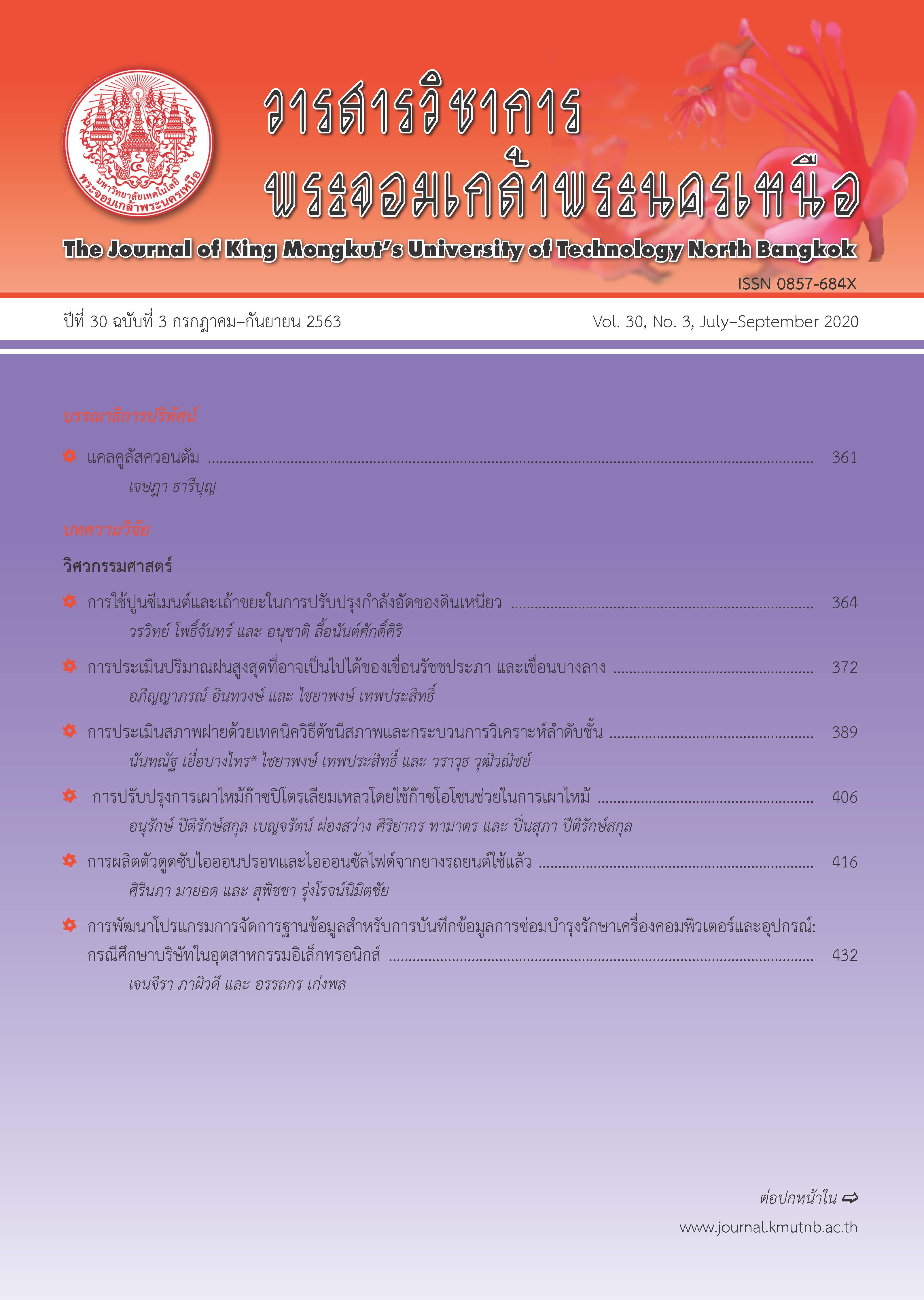การปรับปรุงการเผาไหม้ก๊าซปิโตรเลียมเหลวโดยใช้ก๊าซโอโซนช่วยในการเผาไหม้
Main Article Content
บทคัดย่อ
งานวิจัยนี้มีจุดประสงค์เพื่อศึกษาการเติมโอโซนในปฏิกิริยาการเผาไหม้ที่มีผลต่ออุณหภูมิการเผาไหม้และความเร็วการเผาไหม้ ในการทดลองการเผาไหม้นี้ชุดทดสอบประกอบด้วยถังบรรจุก๊าซปิโตรเลียมเหลว ปั๊มลม เครื่องกำเนิดโอโซนและหัวเผาไหม้ โดยก๊าซปิโตรเลียมเหลวจะถูกลดความดันแล้วผสมเข้ากับอากาศ และก๊าซโอโซนก่อนที่จะเข้าสู่หัวเผาไหม้ซึ่งออกแบบเป็นชนิดสล็อตสี่เหลี่ยมที่มีขนาด 3x25 ตารางมิลลิเมตร โดยการทดลองในส่วนแรกเป็นการทดลองเพื่อเปรียบเทียบประสิทธิภาพการเผาไหม้ที่อัตราส่วนสมมูล (Φ) 6.31 ในระบบที่มีโอโซนและไม่มีโอโซน ในช่วงความเข้มข้นโอโซนที่ 0 ถึง 1,000 มิลลิกรัมต่อชั่วโมง ผลการทดลองพบว่า หากไม่มีการป้อนโอโซน อุณหภูมิการเผาไหม้สูงสุดที่วัดได้เท่ากับ 705.5 องศาเซลเซียส และมีความเร็วการเผาไหม้เท่ากับ 0.043 เซนติเมตรต่อวินาที ส่วนที่ความเข้มข้นโอโซน 1,000 มิลลิกรัมต่อชั่วโมงให้ค่าอุณหภูมิการเผาไหม้สูงสุดที่ 885.5 องศาเซลเซียส และความเร็วการเผาไหม้ 0.082 เซนติเมตรต่อวินาที การทดลองในส่วนที่สองเป็นการเผาไหม้โดยลด Φ จาก 6.31 เป็น 3.31 โดยทดสอบการเผาไหม้ที่ไม่มีโอโซนและที่มีการป้อนโอโซนจนถึงความเข้มข้น 1,000 มิลลิกรัมต่อชั่วโมง พบว่า เมื่อไม่มีโอโซนจะให้อุณหภูมิสูงสุดที่ 705.5 และ 790.8 องศาเซลเซียส ตามลำดับ แต่เมื่อมีการเติมโอโซนที่ 1,000 มิลลิกรัมต่อชั่วโมง อุณหภูมิสูงสุดมีค่าประมาณ 890 องศาเซลเซียส ทั้งที่ Φ 6.31 และ 3.31 และความสัมพันธ์ระหว่างความเร็วการเผาไหม้กับความเข้มข้นของโอโซนแสดงเป็นแบบเชิงเส้น โดยเมื่อ Φ มีค่าลดลงความเร็วการเผาไหม้มีค่าเพิ่มขึ้นในช่วงความเข้มข้นตั้งแต่ 0 ถึง 1,000 มิลลิกรัมต่อชั่วโมง
Article Details
บทความที่ลงตีพิมพ์เป็นข้อคิดเห็นของผู้เขียนเท่านั้น
ผู้เขียนจะต้องเป็นผู้รับผิดชอบต่อผลทางกฎหมายใดๆ ที่อาจเกิดขึ้นจากบทความนั้น
เอกสารอ้างอิง
[2] Z. H. Wang, L. Yang, B. Li b, Z. S. Li, Z. W. Sun, M. Alden, K. F. Cen, and A. A. Konnov, “Investigation of combustion enhancement by ozone additive in CH4/air flames using direct laminar burning velocity measurements and kinetic simulations,” Combustion and Flame, vol. 159, no. 1, pp. 120–129, 2012.
[3] E. Varea, J. Beeckmann, H. Pitsch, Z. Chen, and B. Renou, “Determination of burning velocities from spherically expanding H2/air flames,” Proceedings of the Combustion Institute, vol. 35, no. 1, pp. 711–719, 2015.
[4] T. Boushaki, Y. Dhué, L. Selle, B. Ferret, and T. Poinsot, “Effects of hydrogen and steam addition on laminar burning velocity of methane-air premixed flame: Experimental and numerical analysis,” International Journal of Hydrogen Energy, vol. 37, no. 11, pp. 9412–9422, 2012.
[5] J. Buffam, K. Cox, and H. Schiess, (2019, September). Measurement of Laminar Burning Velocity of Methane-Air Mixtures Using a Slot and Bunsen Burner. [Online]. Available: https://web.wpi.edu/Pubs/E-project/Available/Eproject-042308-085413/ unrestricted/Laminar_Burning_Velocity_of_Methane-Air_Mixtures.pdf
[6] W. Sun, X. Gao, B. Wu, and T. Ombrello, “The effect of ozone addition on combustion: Kinetics and dynamics,” Progress in Energy and Combustion Science, vol.73, pp. 1–25, 2019.
[7] Energy Policy and Planning Office. (2018, October). Energy Statistics of Thailand 2018, EPPO, Ministry of Energy. Bangkok, Thailand [Online]. Available: http://www.eppo.go.th/index.php/th/component/k2/item/14166-energy-statistics-2561
[8] Thai Energy Conservation, “Operation Manual of Ozone Generator,” Thai Energy Conservation Co.,LTD.
[9] G. Broustail, P. Seers, F. Halter, G. Moréac, and C. Mounaim-Rousselle, “Experimental determination of laminar burning velocity for butanol and ethanol iso-octane blends,” Fuel, vol. 90, no. 1, pp. 1–6, 2011.
[10] K. Coudoro, N. Chaumeix, B. Ahmed, and C-E Paillard, “Laminar flame velocities and fundamental properties for two methane based mixtures: G27 and G222,” presented at the 23rd ICDERS, Irvine, USA, July 24–29, 2011

